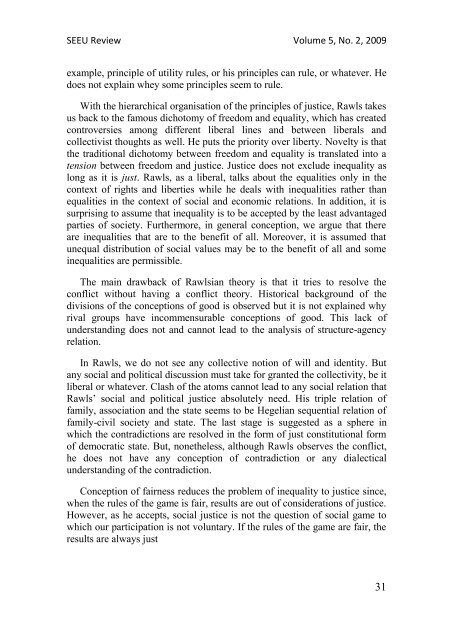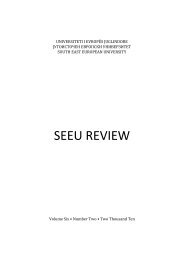SEEU Review vol. 5 Nr. 2 (pdf) - South East European University
SEEU Review vol. 5 Nr. 2 (pdf) - South East European University
SEEU Review vol. 5 Nr. 2 (pdf) - South East European University
You also want an ePaper? Increase the reach of your titles
YUMPU automatically turns print PDFs into web optimized ePapers that Google loves.
<strong>SEEU</strong> <strong>Review</strong> Volume 5, No. 2, 2009<br />
example, principle of utility rules, or his principles can rule, or whatever. He<br />
does not explain whey some principles seem to rule.<br />
With the hierarchical organisation of the principles of justice, Rawls takes<br />
us back to the famous dichotomy of freedom and equality, which has created<br />
controversies among different liberal lines and between liberals and<br />
collectivist thoughts as well. He puts the priority over liberty. Novelty is that<br />
the traditional dichotomy between freedom and equality is translated into a<br />
tension between freedom and justice. Justice does not exclude inequality as<br />
long as it is just. Rawls, as a liberal, talks about the equalities only in the<br />
context of rights and liberties while he deals with inequalities rather than<br />
equalities in the context of social and economic relations. In addition, it is<br />
surprising to assume that inequality is to be accepted by the least advantaged<br />
parties of society. Furthermore, in general conception, we argue that there<br />
are inequalities that are to the benefit of all. Moreover, it is assumed that<br />
unequal distribution of social values may be to the benefit of all and some<br />
inequalities are permissible.<br />
The main drawback of Rawlsian theory is that it tries to resolve the<br />
conflict without having a conflict theory. Historical background of the<br />
divisions of the conceptions of good is observed but it is not explained why<br />
rival groups have incommensurable conceptions of good. This lack of<br />
understanding does not and cannot lead to the analysis of structure-agency<br />
relation.<br />
In Rawls, we do not see any collective notion of will and identity. But<br />
any social and political discussion must take for granted the collectivity, be it<br />
liberal or whatever. Clash of the atoms cannot lead to any social relation that<br />
Rawls’ social and political justice absolutely need. His triple relation of<br />
family, association and the state seems to be Hegelian sequential relation of<br />
family-civil society and state. The last stage is suggested as a sphere in<br />
which the contradictions are resolved in the form of just constitutional form<br />
of democratic state. But, nonetheless, although Rawls observes the conflict,<br />
he does not have any conception of contradiction or any dialectical<br />
understanding of the contradiction.<br />
Conception of fairness reduces the problem of inequality to justice since,<br />
when the rules of the game is fair, results are out of considerations of justice.<br />
However, as he accepts, social justice is not the question of social game to<br />
which our participation is not <strong>vol</strong>untary. If the rules of the game are fair, the<br />
results are always just<br />
31

















